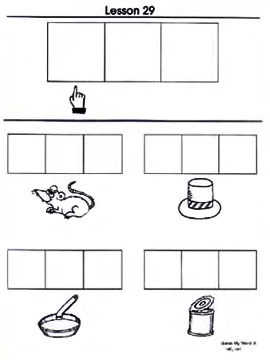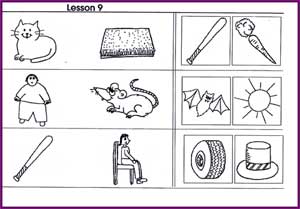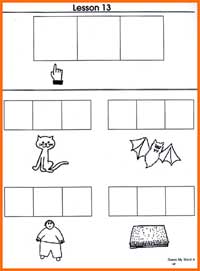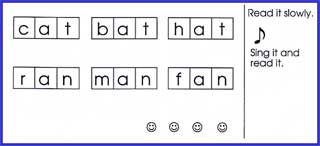What types of activities can the teachers at Washington Elementary use to increase their students’ reading skills?
Page 3: PALS Activities for Kindergarten Students
Although the teachers at Washington Elementary have always set ambitious goals for their students, they are somewhat surprised to learn that PALS for kindergarten students (K-PALS) targets more advanced reading skills than typically taught at this level. Nevertheless, research has shown that most students can successfully perform the activities.
Research Shows
- Students in kindergarten benefit from decoding and word recognition instruction.
(Fuchs and Fuchs, 2005) - K-PALS promotes early reading skills in kindergarten students, including those with disabilities.
(Fuchs, Fuchs, Al Otaiba, Thompson, Yen, McMaster, Svenson, & Yang, 2001) - Students receiving K-PALS out performed students in the teacher-led instruction and control groups on a measure of word reading.
(Fuchs, Fuchs, Thompson, Svenson, Yen, Al Otaiba, Yang, McMaster, Prentice, Kazdan, & Saenz, 2001)
Devin Kearns and Stephanie Johnson emphasize that students as young as kindergarten can successfully implement PALS, while Nichole Lawson also explains how PALS helped her to meet the curricular goals set forth for this grade level.

Stephanie Johnson
Kindergarten teacher
Westwood Elementary School
Bloomington, Minnesota
(time: 0:32)

Nichole Lawson
First-grade (and former kindergarten) teacher
Interdistrict Downtown School
Minneapolis, Minnesota
(time: 0:46)
Transcript: Devin Kearns, MA
A lot of teachers worry about the kindergarten program for a number of reasons. First of all, people worry that the students aren’t going to be able to handle the content. Kindergarten PALS moves very quickly, and it teaches a lot of skills, and kindergarten teachers, at first, are frankly shocked that we teach all of these skills in a kindergarten program. And they’re also very concerned that the students won’t be able to do the pair activities, and so they think that the program isn’t feasible. So let me address each of those concerns. The first concern that students won’t be able to handle material, we’ve actually not found to be true at all. And teachers are both amazed and excited by what they’ve learned their kindergarteners can do in kindergarten PALS. As far as the management of kindergarteners doing these pair activities, the first thing to know is that we ease students into the pair activities. They don’t get into pairs the first day and start doing all those things. We really ease them into that. The entire first few weeks is mostly group activities, and they do little tiny bits in pairs. And over the year the amount of time they spend in pairs increases as the students are better able to handle it. Students are slowly introduced to activities of greater difficulty. In the kindergarten program, they begin just by doing phonological and phonemic awareness activities. They do things like clapping syllables and counting sounds, and then over a period of time they get into saying the sounds of letters, and then they say sight words, and then they start reading words using an activity we call Sound Boxes, and then finally they learn to do sentences, and by the end of the year they’re reading books.
Transcript: Stephanie Johnson
It really doesn’t seem like it’s too much for a kindergartener or young child. Because we do it four days a week is almost better for a lot of my students because they know what to expect in a structured activity. It’s all the same. It’s different letters, and they’re always looking for different letter, that different word of the week. But they know what to expect. They have a routine, and sometimes that’s probably the easiest part of their day, is PALS, when they know exactly what’s happening.
Transcript: Nichole Lawson
Kindergarteners had to know by the end of the year twenty-five sight words, and they had to know all their letters and their sounds, and that’s where the PALS was a lifesaver because it reinforces the very things I needed to teach them anyway. So, as far as the sight words, many of them were in the PALS program. As far as letter sounds recognition, that came from the PALS program. As far as early reading, that also came from the PALS program. So it actually cut down some of my stress and frustration and anxiety because at the end of the year teachers as well as the students were judged on whether or not they met the outcomes. PALS was wonderful, in that it provided that opportunity for them to meet the exact same things I had to do anyway.
K-PALS Activities
K-PALS sessions typically last 20–30 minutes and are conducted at least three times per week. A session consists of two types of activities: Sound Play and Sounds and Words. The table below highlights the reading games or tasks for each activity and the skills they address. Click on the links to learn more about each game.
 Activity Activity |
 Skill Skill |
 Games and Tasks Games and Tasks |
Sound Play
|
Phonological Awareness | |
|
First Sound Game Skill: Phonological Awareness – Identifying first sounds in words
Implementation Procedure: Each lesson page features pictures of common animals and objects. The teacher (i.e., Coach) says the name of the object(s) on the left-hand side of a given row followed by the first sound of those object(s). The Reader (i.e., student) selects the object in the right-hand column that has the same beginning sound and says its beginning sound. Example: In the example to the right, the Coach would say, “Apple, /a/, alligator, /a/. What starts with /a/, hat or ax?” The Reader should then answer, “Ax, /a/.”Note: The teacher may reinforce the skill by saying, “Good. Let’s review the /a/ words. Apple /a/, alligator /a/, ax /a/.” Corrective Feedback Procedure: If the Reader makes a mistake, the Coach says the correct word and pronounces its first sound. (Close this panel) Last Sound Game Skill: Phonological Awareness – Identifying last sounds in words
Implementation Procedure: Each lesson page features pictures of common animals and objects. The Coach says the name of the first two objects in a given row followed by the last sound in that word. The Reader then selects the object from the right-hand column that has the same ending sound, speaking the word. Example: In the example to the right, the Coach would say, “Cat, /t/, boat, /t/. What ends with /t/: apple or foot?” The Reader should respond by saying, “Foot, /t/.” Corrective Feedback Procedure: If the Reader makes a mistake, the Coach says the correct word and pronounces its last sound. (Close this panel) Rhyming Game Skill: Phonological Awareness – Rhyming
Implementation Procedure: This activity requires the Reader to decide which word in a pair belongs to the same family as two previous words. Example: In the example to the right, the Coach would say, “Cat, mat. What rhymes with cat and mat, bat or carrot?” The Reader should answer “Bat.” Corrective Feedback Procedure: If the Reader makes a mistake, the Coach says the correct word. (Close this panel) Clap the Syllables
Skill: Phonological Awareness – Segmenting words Implementation Procedure: Each lesson page features pictures of common animals and objects. The Reader claps the number of syllables in a given word. Example: In the example to the right, the Coach says, “Clap mitten.” and the Reader responds, “mit [clap] ten [clap].” Corrective Feedback Procedure: If the Reader makes a mistake, the Coach claps for each syllable. (Close this panel) Guess My Word Game
Skill: Phonological Awareness – Segmenting and blending words Implementation Procedure: Each lesson page features pictures of common animals and objects. The Coach points to the boxes on the lesson sheet and says each corresponding sound. The Reader points to the boxes, says each sound, and pronounces the word. Example: In the example to the right, the Coach points to the boxes and says /c/ /a/ /t/. The Reader repeats the process and then pronounces the word “cat.” Corrective Feedback Procedure: If the Reader makes a mistake, the Coach points to the boxes near the picture, pronounces each sound, and then says the word. (Close this panel) |
||
Sound and Words
|
Decoding and Word Recognition | |
|
What Sound? Skill: Decoding Implementation Procedure: For each lesson, individual target sounds appear in a box with a key picture that has been introduced in the Sound Play activities. The Coach points to each letter and asks, “What sound?” The Reader responds. The Coach praises the Reader at each star (e.g., “Good job.”). Note: A new sound is introduced every other lesson.
Corrective Feedback Procedure: If the Reader makes a mistake, the Coach corrects the error by saying, “Stop. That sound is __. What sound?” After the Reader responds with the correct answer, the Coach says, (Close this panel) What Word? Skill: Sight word recognition Implementation Procedure: The Coach points to the sight word on a lesson page and asks, “What word?” and the Reader responds.
Corrective Feedback Procedure: If the Reader makes a mistake, the Coach corrects the error by saying, “Stop. That word is ______. What word?” After the Reader responds with the correct answer, the Coach says, (Close this panel) Sound Boxes Skill: Decoding simple words Implementation Procedure: Students learn that words can be sounded out using letter sounds practiced in their earlier lessons. Each letter in a word appears in a sound box. The Coach says, “Read it slowly.” The Reader slowly reads the sound of each letter while touching the letter in each box. The Coach then says, “Sing it and read it.” The Reader “sings” the word by blending the sounds together. The Reader then reads the word quickly.
Corrective Feedback Procedure: If the Reader makes a mistake, the Coach corrects the error by saying, “Stop. That word is ______ [slowly blending the letter sounds, for example “mmmaaat”]. What word?” After the Reader responds with the correct answer, the Coach says, (Close this panel) Reading Sentences and Books Skill: Decoding and word recognition Implementation Procedure:
Corrective Feedback Procedure: If the Reader makes a mistake, the Coach corrects the Reader by saying, “Stop. That word is ______. What word?” After the Reader responds, the Coach says, (Close this panel) |
||
K-PALS sessions are highly structured and follow a prescribed sequence:
-
- The teacher conducts whole-group instruction in which he or she leads the students through the Sound Play activity. Only one of the five Sound Play games (listed in the table above) will be implemented during a session.
- The teacher briefly introduces the Sounds and Words lesson. A new sound is introduced in every other lesson. With the exception of “x,” all letter sounds are introduced.
- The student pairs complete the Sounds and Words lesson.
The sounds introduced in Sound Play activities often correspond to those that will be practiced in the Sounds and Words activities. In the examples below, note that the corresponding Sound Play and Sounds and Words lessons focus on the same sounds (i.e., “at” and “an”).
| Sound and Words Activity – Lesson 29 | Sound Play Activity – Lesson 29 |
 |
 |






 Example: In the example to the right, the Coach begins by pointing to the letter “a” in the top row and asks, “What sound?” The Reader responds /a/.
Example: In the example to the right, the Coach begins by pointing to the letter “a” in the top row and asks, “What sound?” The Reader responds /a/. Example: In this example, the Coach begins by pointing to the word “I” and asking, “What word?” The Reader responds with “I.” They continue this process for each word.
Example: In this example, the Coach begins by pointing to the word “I” and asking, “What word?” The Reader responds with “I.” They continue this process for each word. Example: In the example to the right, the Coach says, “Read it slowly.” The Reader touches each letter in the word “cat” and says the sounds /c/ /a/ /t/. The Coach says, “Sing it and read it.” The Reader sings the word “cat” and then reads the word quickly.
Example: In the example to the right, the Coach says, “Read it slowly.” The Reader touches each letter in the word “cat” and says the sounds /c/ /a/ /t/. The Coach says, “Sing it and read it.” The Reader sings the word “cat” and then reads the word quickly. Example: In this example, the Coach says, “Read the sentence.” The Reader points to each word, beginning with “Tom,” as he or she reads.
Example: In this example, the Coach says, “Read the sentence.” The Reader points to each word, beginning with “Tom,” as he or she reads.